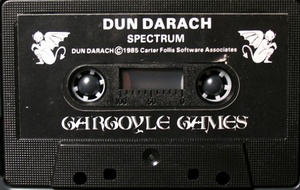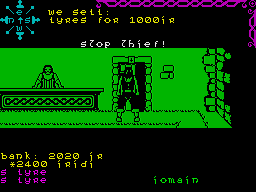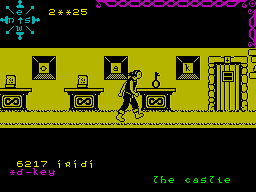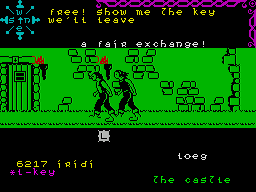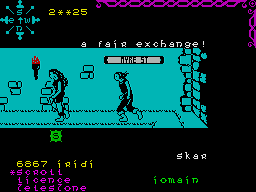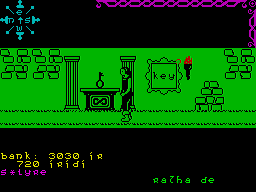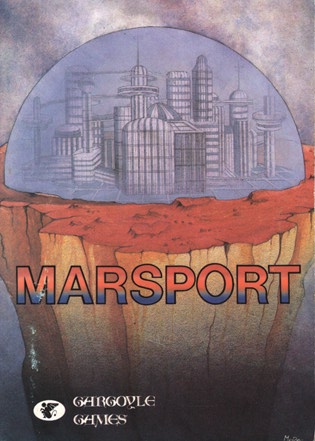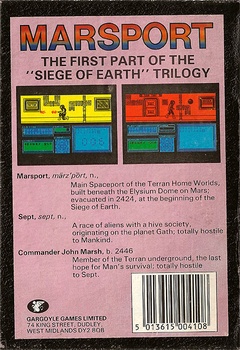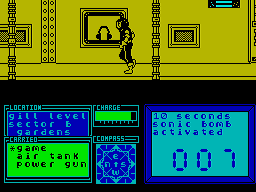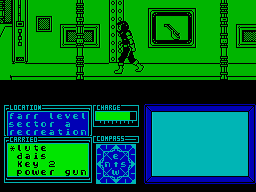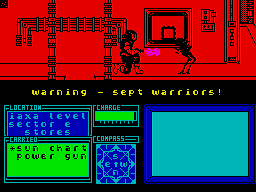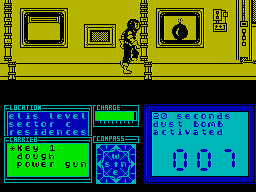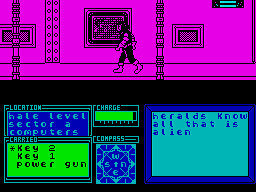

|
Page 1 |
Page 2 |
Page 3 |
Page 4 |
|
Gargoyle's second adventure game was initially based on Lewis Caroll's The Hunting of the Snark. Interviews from as late as 1987 make it clear that it was Greg Follis's dream project, but it never came to be. The surprise success of Tir Na Nog led them to instead make a prequel follow-up originally titled Cú Chulainn - The Early Years.
Cú Chulainn and his trusty charioteer, Leog, are returning home from battle. Resting at an inn, a beautiful woman named Skar coaxes Leog into leaving Chulainn. Unfortunately, Skar is a sorceress who kidnaps Leog as payback for Chulainn killing a prince named Amhair. Leog is being held captive in the titular city of Dun Durach, and Chulainn must save him.
While Dun Darach looks very similar to Tir Na Nog, Greg and Roy claimed only the central character and the scrolling routines were the same. The rest of the game was built from scratch, and in many ways, it's an entirely different experience.
For one, the game world is much smaller. The original design featured a hundred streets and forty shops to explore, but the final product featured only fifty-five streets and few stores. Perhaps the most infamous omission was the removal of a full red-light district that was supposed to fill up the center of the map. Lady Q's store was intended to be brothel, showcasing a scene featuring prostitutes that opened up the seedy underbelly of the city. Evidently this posed a problem, so the team just ripped that portion of the map out of the game and placed a "forbidden" sign over Lady Q's. As the game was published by Gargoyle themselves, it probably was an act of self-censorship to avoid having their meal ticket labeled a proverbial video game nasty.
Although the streets in the game took up a minimal amount of space on the cassette, the game's myriad of new characters was much more taxing on storage. They're all fully animated "walking man" clones, programmed to move along a set circuit path the entire game. These people are all individually named and accomplish a variety of tasks: some trade quest items, many offer hints, and others steal important inventory items or money. Since the game eschews any sort of combat, thieves quickly become the only real enemy as integral quest or trade items can be quickly lost, forcing the player to maneuver all the way across town to grab another moleskin or gold bar.
Crash Magazine's Roger Kean stated that the game is almost like a "financial simulation", and while this is a wild overstatement, finances play a huge role in Dun Darach. Buying, selling, and potentially stealing from merchants is the key to completing the game. While money can be earned by buying lyres low and selling them high at different stores, there also is a casino that can be easily exploited via the save system. Theft isn't strictly punished either: if you're caught stealing goods, the store owner simply locks the door until you drop the item or pay for it. Policemen like Ryde can also confiscate your stolen goods, but if you've bought a Thieve's Guild membership card, they overlook the misdeed. There's even a bank where interest is incurred on deposits.
While the economy is easily tamed, the puzzles are not. Dun Darach is in a few ways easier and in most ways even more enigmatic than Tir Na Nog. Some solutions are obvious: characters like Dain will simply ask for a lyre, making life ten times easier. Of course, most puzzles are far more intricate. To navigate the maze-like castle, we need to find Skar, who's strolling around Dun Darach with an invisibility enchantment that must be dispelled. Once this has been accomplished, get ready to brush up on ZX Basic, because knowledge of this archaic programming language is crucial to solving the puzzle. Either way, while the game world is smaller, it will take more time to uncover its secrets.
While Dun Darach doesn't have the massive size of Tir Na Nog, the game is much more devious. Everything is easier to map, but it's harder to get from one place to another without something being stolen. There are more hints, yet there are just as many red herrings. With every obvious answer, there are two incredibly obscure riddles. For the adventurer who appreciates a grand challenge, Dun Darach will exceed all expectations.
Critics hailed the game as an instant classic upon its mid-1985 release on the Spectrum and Amstrad. Most reviewers praised the new features and the greater variety of animations, boasting that Dun Darach greatly surpassed its predecessor in sheer quality. Again, the only difference between the Spectrum and Amstrad versions are the latter has more color and occasional slowdown issues.
As with most Gargoyle Games releases, reissues were a common occurrence. Rebound quickly re-released it the following year, Gremlin Graphics reissued it in 1986 in its 4 Crash Smashes compilation, and it was featured in the covertapes of Sinclair User 119 and Your Sinclair 63.
In 2011, Luny, a UK programmer who grew up playing software the ZX Spectrum, started work on Scrolly Adventures, an android adaptation of Dun Darach. The current demo build features the character and camera options from the original game. Holding the left and right sides of the screen moves the "walking man", and pressing the bottom of the screen rotates the camera 90 degrees. Most of Luny's progress is detailed on his website and on the Retro Remakes message boards, although development eventually stalled. His site features the current demo and information on his favorite Spectrum developers, including Gargoyle Games.
Scrolly Adventures (Android)
Quick Info:
|
Developer: |
|
|
Publisher: |
|
|
Designer: |
|
|
Genre: |
|
|
Themes: |
Dun Darach (ZX Spectrum)
Dun Darach (ZX Spectrum)
Dun Darach (ZX Spectrum)
Dun Darach (ZX Spectrum)
Dun Darach (ZX Spectrum)
Dun Darach (ZX Spectrum)
Dun Darach (ZX Spectrum)
After two popular titles with a Celtic myth theme, Carter and Follis were ready for something new. Roy started all his coding from scratch and Greg started planning for an epic science fiction trilogy that would reinvent the Gargoyle adventure.
Marsport was intended to be the first in a trilogy called the Siege of Earth, which was to be followed by the sequels Fornax and Gath. According to Greg in various interviews, the series would have spanned centuries and shown humanity attempting to explore space, encountering aliens, and fleeing to Earth for an epic battle to save mankind. In preparation for Fornax, Greg and Roy evidently took artificial intelligence classes to incorporate cutting edge programming techniques. Unfortunately, these sequels never surfaced. While Marsport isn't quite the stylistic rebirth they intended, Gargoyle did reinvent their acclaimed design style with varying degrees of success.
In 2494, Earth has been defending itself against the Sept race for decades. The Sept are only kept at bay by a giant forcefield that contains both the Earth and its moon. However, the forcefield is weakening and must be strengthened by the original plans, located deep below the surface of Mars in the Marsport base. Unfortunately, the complex is currently occupied by the Sept, and you, as Commander John Kepler Marsh of the Terran underground liberation organization HASP, must recover the plans from Marsport's central computer.
As Marsh must fight the Sept, Marsport contains very light action elements. The very first puzzle in the game is to grab a gun permit, walk nearby, put the permit in a receptacle labeled key, and grab a gun from an adjacent shelf. Guns are the only defense against hundreds of fast moving enemies. They hold about thirty shots, after which they must be charged at specified stations. Thirty is more than enough ammo before reaching the next charging station, making everything straightforward shoot-em-up fair. It would have been interesting if Greg and Roy limited it to five or ten shots per charge; if they had done this, the game would have an almost survival horror level of intensity.
Instead, there's hardly an element of surprise. The game always flashes an onscreen warning whenever enemies are present. Only one type of the game's three enemies appear in each section.
Sept Warrior
Sept warriors are by far the most common. These humanoid insects prance up to the player with no inhibitions and kill upon contact. These are easily dispatched with a single blast. They re-spawn continuously and have a nasty habit of popping out around corners, so it's best to take it slow when they're in the area.
Warden
Wardens are robots that also kill the player on touch, though they move diagonally up and down and can only be killed at their lowest point of movement. Because of this, wardens are a greater challenge than other foes, requiring carefully timed crouching attacks to subdue.
The objectives are clearly stated in the manual: locate Marsport's main computer, recover the forcefield plans, and get out alive. However, the complex is huge, featuring many levels linked by elevators. These aren't the kind of elevators that have nice floor select buttons; they drop Marsh off on whatever floor they want, and with ten floors, there's a complex layered approach to mapping. Many of the elevators, similar to the tubes in Wizardry, are one-way, meaning long and elaborate backtracking is mandatory.
Gargoyle's inventory slog approach is back, but there are plenty of strange twists. As always, random items are all over the place, but now they are easy to find. Most items are infinitely generated by supply units in the walls, allowing infinite access to objects. This also means that the same items can be used for multiple puzzles, a design element that many adventure games today still avoid. In case the wrong item is grabbed, the player can throw anything out in special refuse receptacles. While it's not as convenient as dropping it anywhere on the path, it's still pretty easy to manipulate the item system as long as your maps are detailed.
At various points throughout the game, Marsh will encounter trap airlocks. Before entering, a video screen warns the player that there is some environmental problem, whether it's lack of oxygen, a bomb, or poisonous gas. Usually, the exact item required doesn't exist, whether it's a gas mask or an oxygen tank. This is where item fusion comes in.
Throughout the game, basic items need to be fused together at factor stations. Similar to crafting elements featured in many titles today, items are put into a container and formed into new tools. The items you create either become important keys or life-savers in the trap area. Some item crafting makes sense: a cake can be made using flour, a baking tin, and water. Others are downright bizarre, like gauze and charcoal combining to make a gas mask. Depending on the puzzle, this makes solutions much more predictable or incredibly difficult.
Most of the illogic appears in the game's second half where you must manufacture lettered tokens. Their combinations are hinted at through incredibly obscure clues which most sane people will ignore in lieu of simply looking up a walkthrough. Even worse, the items needed to make these tokens are inconveniently placed on opposite sides of the base. Mixing a nonsensical puzzle with an hour long trek is never a recipe for player satisfaction.
Because of the one way elevators, Marsh will frequently have to go through the exact same corridors and trap airlocks multiple times to accomplish anything. Players will probably go through the dust bomb area over a hundred times before solving the game. To alleviate some of the strain, the game rewards the player after unlocking the main computer area, opening up formerly restricted areas. This gives access to both new areas and easier routes to old, although it hardly changes the backtracking procedures. Meandering about looking for new item combinations is the name of the game until the very end. None of this would really matter if John Marsh could stuff his pockets silly a la every LucasArts game, but Gargoyle's four item limit on inventory space remains. There are some conveniently located lockers that items can be stored in, but it's difficult to tell what is really needed without thorough experimentation. Either way, there's going to be more walking than ever before.
There's little to break up this monotony aside from a mini-game found near the final area. Starting on one side of a three by three grid, the player has to move three pawn-like pieces into any three-in-a-row position. It's definitely an interesting addition and not one common to early graphic adventures.
Despite the constant backtracking, Marsport remains fun. The shooting sections are cool in spurts, and Gargoyle's typical graphical touches remain a treat. Gargoyle purists will find a lot to love about Marsport's intricate maps and obtuse puzzles, but the uninitiated will start pulling their hair out at the half hour mark.
When released in November 1985 on the Spectrum, Marsport received rave reviews. Many concentrated on the large game world and, as usual, the animated graphics. A few felt noted the game was much more frustrating than its predecessors due to the constant mapping, but the majority of publications agreed that Marsport was another Gargoyle gem.
This time, the Amstrad version is largely identical to the Spectrum original. The game runs smoothly and retains the exact same color scheme.
In 1989, Marsport was re-released alongside every other Gargoyle adventure game on Rebound's Gargoyle Classics compilation. The game also appeared on Activision's Kidsplay compilation in 1987 and was featured on the covertape of Sinclair User 120 and Your Sinclair 62.
Quick Info:
|
Developer: |
|
|
Publisher: |
|
|
Designer: |
|
|
Genre: |
|
|
Themes: |
Marsport (ZX Spectrum)
Marsport (ZX Spectrum)
Marsport (ZX Spectrum)
Marsport (ZX Spectrum)
Marsport (ZX Spectrum)
Marsport (ZX Spectrum)
Marsport (ZX Spectrum)
Marsport (ZX Spectrum)
Marsport (ZX Spectrum)
|
Page 1 |
Page 2 |
Page 3 |
Page 4 |
|

